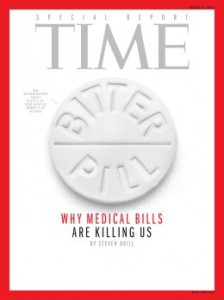The Thing to Read This Weekend is: “Bitter Pill”

Yesterday, TIME published its longest story in history — a 36-page investigation by Steven Brill on the craziness of medical billing in the U.S. It took me a little more than two hours to read, but it’s worth it and it’s the story I’m encouraging everyone to read this weekend. Why does a run to the hospital for a heart attack scare that ends up being heartburn result in a bill for $21,000? The word that we learn and that’s brought up several times throughout the story is: chargemaster. The chargemaster is the hospital’s internal price list, a massive computer file that assigns prices to everything from blood tests to every square of cotton used (“alcohol prep pad”) to treat you while you’re in the hospital. To summarize, insurance companies and programs like Medicare negotiate big discounts off of the chargemaster figures, so a $21,000 heartburn bill will cost an insurance company, say, $10,000 minus a copay fee. Patients often pay $50 or $100 copays for their treatments not realizing that their bill was $21,000.
But one of the people in the TIME story, Janet S., a 64-year-old uninsured woman who had a heart attack scare that turned out to be heartburn did get to see her $21,000 bill because she didn’t have a health insurance provider negotiating a discount on the chargemaster figures on her behalf. She was asked to pay the chargemaster list prices: $17,000 for the hospital, $3,000 for the doctors who treated her, and $995 for an ambulance ride. If she were a year older and qualified for Medicare, her bill would have been much lower. Among many other charges she received three “TROPONIN I” tests (basically, blood tests) for $199.50 each.
…seeing what Medicare would have paid Stamford Hospital for the troponin test if she had been a year older shines a bright light on the role the chargemaster plays in our national medical crisis — and helps us understand the illegitimacy of that $199.50 charge. That’s because Medicare collects troves of data on what every type of treatment, test and other service costs hospitals to deliver. Medicare takes seriously the notion that nonprofit hospitals should be paid for all their costs but actually be nonprofit after their calculation. Thus, under the law, Medicare is supposed to reimburse hospitals for any given service, factoring in not only direct costs but also allocated expenses such as overhead, capital expenses, executive salaries, insurance, differences in regional costs of living and even the education of medical students.
It turns out that Medicare would have paid Stamford $13.94 for each troponin test rather than the $199.50 Janice S. was charged.
Janice was just a year shy of qualifying for Medicare, and earned too much to qualify for Medicaid, which provides care for the poor, but didn’t earn enough to afford health insurance for herself. Essentially, the person who is least able to pay for medical care is asked by hospitals to pay the highest rates. Why? This is one of the many, many questions the story asks and attempts to answer.
Why does a hospital charge $7 for a single square of cotton used to apply alcohol on a patient when a box of 200 cotton squares can be bought for $1.91? Why does a person like Janice have to worry about a $21,000 heartburn bill and then discover on her own through a “medical-billing advocate” that the bills are actually negotiable? (“’The hospitals all know the bills are fiction, or at least only a place to start the discussion, so you bargain with them,’ says Katalin Goencz, a former appeals coordinator in a hospital billing department who negotiated Janice S.’s bills from a home office in Stamford.”) Goencz negotiated Janice’s bill down to $11,000. And patients are unlikely to go through their bills line by line to prepare themselves for negotiation. As another patient says in the story: “’Are you kidding?’ she said. ‘I’m dealing with a husband who had just been told he has Stage IV cancer. That’s all I can focus on … You think I looked at the items on the bills? I just looked at the total.’”
Do read this story this weekend.
Support The Billfold
The Billfold continues to exist thanks to support from our readers. Help us continue to do our work by making a monthly pledge on Patreon or a one-time-only contribution through PayPal.
Comments